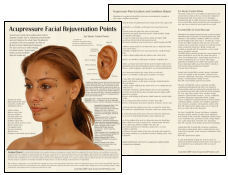Acupuncture & TCM Articles

Articles by Mary Elizabeth Wakefield, LAc, Dipl. Ac., MS, MM
Mary Elizabeth Wakefield has 27 years of clinical professional experience as a healing practitioner, and is a licensed acupuncturist, certified by the NCCAOM, a Zen Shiatsu practitioner, massage therapist, a cranio-sacral therapist, Acutonics® practitioner, opera singer, herbalist and Interfaith minister.
She is a graduate of Tri-State College of Acupuncture in New York City, and has studied with such notable acupuncturists as Carolyn Bengston, Kiiko Matsumoto, Dr. Mark Seem, Arya Nielson, Jeffrey Yuen, Dr. Richard Tan, Fabien Maman, Yitian Ni and Donna Carey.
Her knowledge of facial acupuncture and acupressure is based on the work of Jacques Lavier, the "Father of French Acupuncture." She has also studied extensively with her teacher Carolyn Bengston, who is a master of interdermal needling for the face.
For more information about Ms. Wakefield's Constitutional Facial Acupuncture Renewal™ seminars, please visit her website at www.chiakra.com
Essential Oils, Part One
By Mary Elizabeth Wakefield, LAc, Dipl. Ac., MS, MM and Michel Angelo, MFA
The Aromatic Orchestra: Vibratory Blending According to Music, Fragrance and Color
In our last two columns, we began our exploration of vibratory medicine, through a consideration of the inherent healing attributes of sound.
We introduced the concept that music derives its transformative potential from its inner symmetries, expressed in precise numeric relationships. We also examined theories of musical “medicine’ from both Western and Eastern perspectives, the planetary music of the Greek philosopher Pythagoras, and the Chinese legend of Master Wen “tuning’ the seasons.
This month, we will extend our healing palette to embrace the higher frequencies of sound, fragrance and color, and document how these constituents are brought to bear through the use of essential oils.
The Music of Fragrance
In 1856, G.W. Septimus Piesse, in his book, The Art of Perfumery, conceived the idea that certain fragrances could be seen to correspond to musical tones, and that the “gamut of odors’ might be considered comparable to a musical scale.
Sound, fragrance and color are all expressions of qi and vibration. When these three aspects of vibration are synergized, they produce a result that is more than simply cumulative. Sound produces melody, pigments create color, and essential oils create fragrance.
In summary, essential oils can be viewed as inseparable from sound and color in their impact, and their “concerted’ application produces the olfactory equivalent of a number of virtuosic instruments performing in perfect harmony – in short, an “aromatic orchestra.’
Piesse wrote:
“Scents, like sounds, appear to influence the olfactory nerve in certain degrees. There is, as it were, an octave of colors like an octave in music; certain odors coincide, like the keys of an instrument. Such as almond, vanilla and orange blossom blend together, each producing different degrees of a nearly similar expression.
Again, we have citron, lemon, orange peel, and verbena, forming a higher octave of smells, which blend in a similar manner. The metaphor is completed by what we are pleased to call semi-odors, such as rose and rose geranium, for the half note, pettigrain, neroli, a black key, followed by fleur d´orange …’
Piesse also said that music, color and fragrance all follow mathematical laws that guide us when blending them. They are all vibrational, and as we become composer, color therapist and aromatherapist, we ultimately fuse these seemingly separate “arts’ into “vibrational healing.’
Hippocrates, the father of Western medicine, treated patients with a combination of sound, color, aroma, music, mineral baths and herbal remedies. Chinese medicine, too, recognizes color, sound and aroma in each of the Five Element correspondences, and identification of these components serves as an integral part of diagnosis and treatment.
A Sixth Sense
When we consider the idea of musical tone, a readily accessible analogue for the frequency range that is audible to human hearing (approximately 16 to 20,000 Hz, or cycles per second) is that of the piano keyboard (although the upper note is only 4,000 Hz). The 88 keys of a standard piano embrace only slightly more than seven octaves (an octave consists of 12 individual pitches or tones). In comparison, the visual spectrum presents us with a frequency range of 45 octaves, from the darkest reds to the palest violets; thus, a visual piano “keyboard’ would contain more than six times as many “notes.’
The Russian composer and mystic Alexander Scriabin actually devised a keyboard that would generate specific colors in conjunction with the notes of his musical compositions. Scriabin, like several other classical composers, including Maurice Ravel, experienced combinations of one of more of his senses, in this case, sight and sound; in other words, when he heard musical tones, he saw colors. This is a manifestation of a comparatively rare condition of the brain called synesthesia.
Richard E. Cytowic, MD, has documented the nature of synesthesia in his book, The Man Who Tasted Shapes. He first encountered this phenomenon when a friend was cooking dinner for him one evening. At one point, his host expressed concern that the main course might not be properly prepared, because “there were not enough points on the chicken.’ When Cytowic expressed his curiosity about this utterance, the friend explained, apologetically, that he associated taste with specific shapes, and that he also received tactile impressions.
In the course of his book, Cytowic offers the theory that synesthesia appears to be localized within the limbic, emotional region of the brain, and thus relates to a more primal aspect of brain physiology. In a way, it represents a sixth “synergistic’ sense that is largely dormant in the general population, but which is an intrinsic part of our nature as human beings. This theory provides an interesting counterpart to the viewpoint that the senses are primarily functions of the cerebral cortex; it is the personal emotional relevance of what we perceive in the world that imbues it with meaning for us, and makes it memorable. From an esoteric perspective, we might argue that this provides us with evidence that it is necessary to engage the emotional body in order to effect healing transformation.
In 1905, Albert Einstein, in his Theory of Sympathetic Resonance, postulated that the universe is in a constant state of flow and movement. When molecules vibrate at the same frequency, there is a recognizable exchange of qi; these vibrational impulses of light, sound and aroma affect the limbic brain. In our encounters with other people, similar resonances aroused in the brain through the senses serve as a chemical catalyst. “Like attracts like’ is indeed an appropriate metaphor for these mechanisms of attraction; we are drawn to that compelling stranger because something in our brains is attuned to the same frequency. We seek to establish relationships with those individuals with whom we can “harmonize.’
Plants Are Perfect Healers
In nature, the transmutation of light into energy, through the medium of cholorphyll, forms an integral part of the metabolic cycle of plants. Chlorophyll is analogous in its function to the hemoglobin of human blood; however, chlorophyll is structured around a molecule of copper, whereas hemoglobin is based upon iron. Therefore, when human beings ingest plants, we are, in effect, absorbing the energy of the sun; this is only made possible by this vibratory and molecular affinity. We can also incorporate this vital essence through our use of essential oils, which represent a distillation of the light, aroma and vibratory “soul’ of plant life.
In 1920, Rene Gattefosse, a French chemist, serendipitously stumbled upon the healing properties of lavender essential oil. This occurred after he burned himself with acid in a laboratory accident, and had nothing else available with which to douse the wound. He was not aware of the capacity of lavender for cellular regeneration, and that its chemical effects are cooling; it is perfect for treating burns. Fortunately for him, Gattefosse lived in Provence, which abounds with lavender.
Essential Oils: The Fragrant Path

In light of Gattefosse´s fairly recent discovery about lavender, we tend to forget that the use of essential oils has been fairly constant throughout recorded history. For example:
• The Greeks used essential oils to purify their temples.
• The Bible speaks of frankincense and myrrh being used as a blessing. The three Wise Men brought these oils, more valuable than gold, to the Christ child. Jesus´ feet were bathed in these oils.
• The Elizabethans applied essential oils to their bodies, and to their wigs instead of bathing, because they believed that bathing could make you ill.
• Both the Romans and Greeks massaged essential oils into the skin and scraped the dirt off with a knife.
• During the medieval periods, the oils of rosemary, pine and juniper were burned to counteract the plague; the peoples of these times must have understood that these oils have both antiviral and antimicrobial attributes.
• Cleopatra bathed in rose and orange blossom essential oils.
Essential oils work as anti-aging agents because they stimulate skin cells into a more accelerated rate of reproduction, which reduces the time lag between the elimination of old cells and new skin growth. Skin that is exposed to and treated by essential oil becomes dynamic and stronger. Essential oils:
1) prevent toxic congestion;
2) improve lymphatic flow by speeding up the elimination of toxic debris;
3) improve circulation, which expedites oxygenation of the tissues, and energizes the dermis, so that nutrients may be more readily absorbed;
4) balance the rate at which sebum is produced by the sebaceous glands, which stabilizes the skin environment;
5) are bactericides, and therefore neutralize unfriendly bacteria, preventing blemishes and inflammatory conditions;
6) calm sensitive skin;
7) have phytohormones (some essential oils do), and balance the endocrine system;
8) affect the peripheral nerve endings, and help to reduce stress that contributes to the aging of the skin; and
9) contain nutrients and proteins that nourish collagen and elastin in the skin, both of which contribute to cell regeneration.
Essential oils are indeed our “friends,’ and support us in a multifarious tapestry of healing.
The next article will address the “Doctrine of Signatures,’ and provide an introduction to the unique sound and color signatures of the essential oils; their “notes,’ or rate of evaporation; carrier oils that “ground’ them; and aroma and intensity, and how these affect us. We will also learn how best to apply them to the skin, and essential guidelines for safe usage of the oils.
In part three, we will synergize this information, and discover how the sound, color and aromatic properties of certain essential oils are applicable to a facial acupuncture protocol. This will include an unusual way, as recommended by Piesse, of blending oils according to these qualities, creating miniature tone poems of fragrance that are redolent with vibratory harmony, and dynamic in their healing potency.
References
Cytowic RE. The Man Who Tasted Shapes . The MIT Press; reprint edition, 1998. . The MIT Press; reprint edition, 1998.
Piesse GW Septimus. The Art of Perfumery, and the Methods of Obtaining the Odours of Plants.
|
